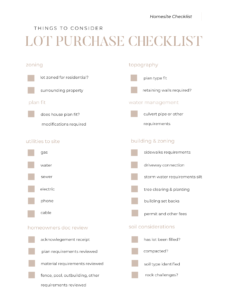Your first step to building your dream home is to find the ideal location.
find the location
 How exciting! Most people have a pretty good idea of the characteristics of the homesite they are looking for as far as area or school district, and if you want a homesite in a neighborhood with other new construction, an established neighborhood, a piece of land in the country, a lake front lot, or a tear-down opportunity. Regardless of what type of lot, there are some things you’ll want to research prior to purchasing your site and you’ll want to discuss with your home builder. They will help you get ahead of things that can impact budget and other building considerations.
How exciting! Most people have a pretty good idea of the characteristics of the homesite they are looking for as far as area or school district, and if you want a homesite in a neighborhood with other new construction, an established neighborhood, a piece of land in the country, a lake front lot, or a tear-down opportunity. Regardless of what type of lot, there are some things you’ll want to research prior to purchasing your site and you’ll want to discuss with your home builder. They will help you get ahead of things that can impact budget and other building considerations.
I highly recommend getting your builder involved right away, even if you have not made a final decision on which builder you are going to use. They have valuable information and it allows you additional time to get to know their company, their processes, and how they communicate.
As a custom home builder, we assist our clients through the lot selection process. In many cases before we have a commitment to build. And that’s ok. There’s much to navigate through before you enter into a formal agreement or contract. By getting involved early we can see opportunities as well as any site challenges before they become an issue.
What do you need to consider when purchasing a lot to build your custom home?
property zoning
We first look at how the property is zoned for the land to be purchased and adjacent property. Your home builder or real estate agent can tell you how a property is zoned and what restrictions it may have or the process for re-zoning.
anticipated house plan and lot restrictions
Make sure that the home you are considering can be built on the lot you are considering. Often times you can buy yourself a little time while in the home building design phase to get things designed and priced out before you purchase.
survey, setback and easement considerations
If your property doesn’t have a survey, you’ll want to have that done, before you design your home. We require a survey for any land we are building so we have topography, setbacks and easements information.
Your local municipality will have setback requirements for your property. While you may wish to set back even more, consider you will be adding costs for your utilities and driveway.
building lot location accommodations
Does your property accommodate areas for materials, and suppliers to store and stage materials and convenient access your property? Are workers able to off load their materials? Is their adequate parking for multiple vendors and suppliers at the home at the same time?
utilities
Check to see if electric, gas, city sewer and water, and communications such as phone and cable have been run to the property. Plan for costs to run keeping in mind there may be connection costs as well.
neighborhood associations
If you are considering building in a neighborhood with an association, get your plans approved in advance to ensure you can build the home you want. The association documents such as the Declaration and Covenants and Restrictions will answer some questions, however, many neighborhoods require architectural approval for plans, exterior elevations, and may only allow certain material and finishes. Some associations also have size and style requirements, so best to have plans approved in advance if you can.
Consult the association in advance for any plans for a fencing, pools, or any out buildings or over-sized garages.
suitable soils and considerations for building pad and adjacent land
If soil testing has not been completed its a good idea to find out what material is on your lot and in the building pad area. A soil engineer can do an assessment and may suggest boring tests to get an idea of what material is below the surface.
Rock can impact costs for things such as digging for the foundation and the utilities. Expansive soils can impact structural and foundation issues. And hazardous materials, such as abandoned fuel or other storage tanks may be a consideration.
If your property was filled discuss what materials and compaction methods were completed to ensure buildable pad.
Ultimately it typically is the homeowners responsibility to ensure suitable soils for your home if you are purchasing a lot. Local building officials or the developer may have records or engineering reports to show how the property was filled. An independent soil engineer can also be consulted to review your situation and provide recommendations and requirements for your building site.
fill material or soil removal
Depending on the topography and your house plan. Soil may need to be added or taken off-site.
In some new neighborhoods the developer may already have done some preliminary grading to assist with the building pad, however, depending on your plan, sometimes soil modifications still need to be considered.
driveways
Consider your driveway costs. Budgets may need to be altered for longer driveways, curb cutting , and connections to public roads. Always check with your builder or local building official to see their requirements.
sidewalks
Another consideration is the cost for sidewalks. Many new construction communities have sidewalks and if they have not been installed, that’s often a costs to the homeowner and may need to be added to your budget. With a large corner lot that certainly would impact costs.
tree and debris clearing
Many municipalities have rules regarding tree removal. Some charge a fee for each tree cut down and some require you to plant trees. Check to see your neighborhood association and local municipality requirements as they also add to your costs to build.
storm water protection
Every property under construction requires water management, typically a silt fence at a minimum. These measure keep dirt and silt from running off construction sites into other areas. Storm runoff can impact water sources such as nearby marshes, ponds, creeks, rivers and lakes and local wildlife.
Check with your local builder or building official so see what special requirements your property has and consider these costs in your budget.
bodies of water/watershed
Extra considerations need to be taken when building near water. You may need additional permits as well. Basements and drain systems must be above the high water levels of any adjacent bodies of water. Special requirements may need to be made as well so consult with your builder and building officials.
consider lot holding costs
There may be other costs involved in lot holding to consider such as, real estate taxes, association dues, insurance, lot maintenance, and a mortgage if you have one.
Check out our Create Home Lot Purchase Checklist for things you may want to consider before purchasing your homesite.

Lot Purchase Checklist

